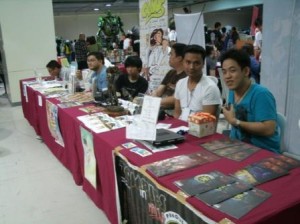By GAIL ORDUÑA

YOUNG independent comics creators are struggling to help revive the local comics industry–once an indelible part of Philippine culture–by crafting something uniquely Filipino in the digital world.
At first blush, Filipino indie (short for independent) comics may appear foreign because of their art style. A closer look though would show they are very different because of their story concepts with a Filipino twist.
One example is “Maktan 1521” by 23-year-old Tepai Pascual. It’s an adaptation of the pre-colonial battle between Cebu datu Lapu-Lapu and Spanish explorer Ferdinand Magellan in Mactan.
Another one is “Patintero” by graphic artist Kai Castillo, also 23, about a Filipino street game which is an official world sporting event.
Most indie comic artists are in their 20s to early 30s with art styles inspired by Japanese or Western comics. Pascual’s “Maktan 1521” was a product of her college thesis four years ago.
About 25 of them with self-made titles joined this year’s Metro Comic Con last May 7 and 8 at SM Megamall, Ortigas.
Despite the gloomy state of the indie comic industry because of the many other forms of popular culture available, indie comic creators still continue to showcase Filipino talent and passion in comics making.
“As long as there are readers, well-made story concept and quality art, why would we stop?” Andrew Arca, one of the comic creators who participated in the event, asked.
Arca, 24, published his first slice-of-life comic “In between” in October last year, and has since released three more series titles with his group Hyper Comics.
Many comic artists say positive feedback inspire them to keep on releasing titles with better story concepts and art styles.
Creators appreciate it more if people also like their works aside from reading them, according to Mel Casipit, 25. His first comic creation “Baboy,” traditionally drawn the pen-and-paper way, won in Komikon 2008’s Comic Creation Contest with the horror theme “Mga Kahindikhindik na Tagpo (Frightening Scenes).”
While others enjoy the privilege of sponsorship, most indie creators rely on their own income to finance their works. They still have to find other sources of income to fund the costs of releasing a comic series–from drafting materials such as pen and paper, to their comics’reproduction.
Casipit said many of them offer extra services such as caricature, tarot reading and merchandise selling to earn a bit more while attracting potential customers.

Filipino comics are usually sold at conventions on different forms of popular culture. Local indie comics are printed in bond paper folded-in-half and sold for as much as P20 to P60, depending on the number of pages.
Most sell only half their stock in conventions catering to broader interests, such as toys, games and anime. The price of a comic issue ranges from P30 for the usual 16-page issue to P50 for one with 24 pages.
“Additional pages lead to additional expenses and price increase, but we make sure that there is also additional quality in (substance and form of) the issue that we release,” Arca said.
She said creators find it hard to look for the cheapest yet best store to photocopy their works.
Also, Pascual said the creation of comic issues has its difficulties whether it is done by an individual, a pair or a group. The burden of production rests on the individual creator, while work ethics, chemistry and dedication are required for pairs and groups to work efficiently.
There is also consideration on whether they will release a one-shot story or a series because the latter is hard to maintain, Casipit said.
Aside from the low quality printing and the lack of sponsors or commercial publications to back them up, their comics do not appeal to many people because of the standards mainstream media had set.
“Indie comics are in the shadows of the mainstream comics, which are, in turn, in the shadows of Western and Japanese comics,” Pascual said.
They often encounter people bashing their works over the counter and even online, and comparing them with the mainstream comics.
“Bashing demoralizes artists,” Pascual lamented. “It loses the drive to keep on producing issues or titles and affects the quality of works to be released.”
While the comics of other cultures influence their art styles, all artists say they try to be different and original.
“Originality is hard to determine, which gives us more reason to improve,” Arca explained. “We should be open-minded to accept other people’s thoughts and learn from them.”
(The author is a University of the Philippines student intern of Vera Files.)
